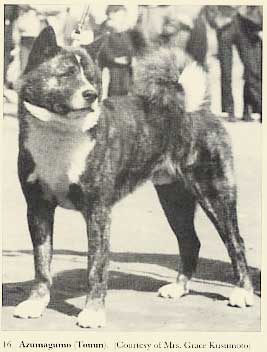 Save this page (88.5 kb)
Save this page (88.5 kb)
Azumagumo
 I saw Azumagumo (Touun) at the Tokyo Matsuda Kennel
I saw Azumagumo (Touun) at the Tokyo Matsuda Kennel
By Tatsuo Kimura
(September/October 2004 Akita World)
I saw the famous male brindle Akita dog, Azumagumo , at the home of Mrs. Yuriko Matsuda in Tokyo during my first trip to Japan in the summer of 1973.
Although others called him Touun , she called him Azumagumo . The name means Eastern Cloud . This could also be read as Shinonome . (On this dilemma of reading Japanese names, please review the four-part article, "A Lesson in Linguistics" by N. Rhoden and J.Hooper found on pages 40-44 in the November/December 2003 issue of Akita World.)
Mrs. Matsuda has never been able to produce another outstanding Akita dog as her Azumagumo . Although he was no longer being used for breeding at that time, Mrs. Matsuda was still advertising Azumagumo in the Akiho Bulletin in 1973, although he was past the age of breeding. She wanted to show the world what she believed to be an ideal Akita dog of that time that came close to the Japanese dog standard. She was critical of many of the Akita dogs that were winning at that time. To her, many Akita dogs at that time were below the standard in size and many of the males lacked the masculine appearance.
Azumagumo won in every show that he was entered from the time he was a young dog.
I was shown the thirteen-year-old Azumagumo soon after being brought back from his daily walk by his caretaker.The dog's muzzle was white ( see photo no. 3 ) due to his age. But he was in good health and still an impressive looking dog.
Before leaving, I thanked the Matsudas for their hospitality and information on the Akita dog.
At home, I decided to look up more information on Azumagumo. Azumagumo (Azumazakura x Gyokurei) was a male brindle whelped at the Tokyo Matsuda Kennel on August 2, 1961. His registry no. at Akiho was 55270 and no.13000 at Nippo. (1) Azumagumo won the championships at the headquarters shows of both dog organizations.
Azumagumo was entered at Nippo's 36th Headquarters Show in 1962 as a Youken (6-10 months). The well-known Nippo judge and writer on Japanese dogs, Mr. Hajime Watanabe had this to say about Azumagumo : "At 9 months, his body structure with adequate bone volume, body height, length, width and balance are excellent. His facial features as a youken (6 to 10 months) has the desirable shibumi (elegant simplicity) and much miryoku (charm, appeal, spellbinding power)." (Nippo Bulletin, 1962) (3)
At the Nippo's 40th Headquarters Show, when Azumagumo was awarded the Nourin Daijinshou (Agriculture and Forestry Minister's Award, the Nippo judge, Mr. Shigeharu Hashimoto , had this to say: "He drew the public's attention because he was an Akita dog from Tokyo. Having just won at the Akiho's headquarters show, the dog seems to be tired from traveling so far to be shown here so soon. His body structure is excellent and shows the excellent features that he inherited from his parents. He also shows that he has received excellent care on a daily basis." (Nippo Bulletin, 1964) (2)
Mr. Masaru Matsuda ( visiting judge at the 1972 Los Angeles Akiho Branch Show ), who judged Azumagumo at one of the Akiho headquarters shows made the following evaluation: "His ability to maintain his powerful tail curl and his calm and alert standing pose is impressive. He continued to maintain his composure when being measured for height after the judging. He did not move when the measuring bar was being pressed upon his back. He is a model dog. The shape of his ears and angulation were excellent. The shape of the forehead and the filling of the cheeks and the course of the cheek lines were also excellent. His features have the desirable shibumi (elegant simplicity; quiet taste). The shape of his face is excellent with much composure in his eyes when he looks at you. His thick neck has the proper angulation. The line from the back of the head to the back is seikaku (correct, accurate, precise), gives the body a powerful masculine appearance.
The tail curl is also excellent. Although his bone is not heavy, his bone structure is solid without any faults. His body height and length are excellent. However, his hind legs seem to be slender. His hocks seem to show shallow angulation. He can hold his posture in the show ring. I saw no faults in his movements. I believe the owner should be commended for the excellent care that this dog has received. If I were to mention any minor faults, his front legs seem to be turned out slightly; his paws needed more roundness. Although his coat was excellent, it had no luster. This may have been due to his nutritional status or to excessive breeding. I would suggest to the owner that this dog could have been shown at a more opportune time." (4)









